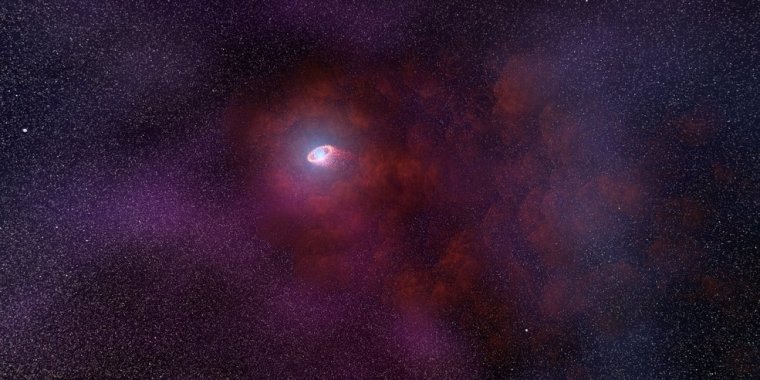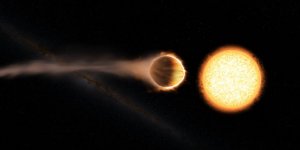| News / Space News |
Hubble Uncovers Never-Before-Seen Features Around a Neutron Star
Although neutron stars are generally studied in radio and high-energy emissions, such as X-rays, this study demonstrates that new and interesting information about neutron stars can also be gained by studying them in infrared light, say researchers.

This is an illustration of a pulsar wind nebula produced by the interaction of the outflow particles from the neutron star with gaseous material in the interstellar medium that the neutron star is plowing through. Credits: NASA, ESA, and N. Tr’Ehnl (Pennsylvania State University)
The observation, by a team of researchers at Pennsylvania State University, University Park, Pennsylvania; Sabanci University, Istanbul, Turkey; and the University of Arizona, Tucson, Arizona, could help astronomers better understand the evolution of neutron stars — the incredibly dense remnants after a massive star explodes as a supernova.
Neutron stars are also called pulsars because their very fast rotation (typically fractions of a second, in this case 11 seconds) causes time-variable emission from light-emitting regions.
“This particular neutron star belongs to a group of seven nearby X-ray pulsars — nicknamed ‘the Magnificent Seven’ — that are hotter than they ought to be considering their ages and available energy reservoir provided by the loss of rotation energy,” said Bettina Posselt, associate research professor of astronomy and astrophysics at Pennsylvania State. “We observe an extended area of infrared emissions around this neutron star — named RX J0806.4-4123 — the total size of which translates into about 200 astronomical units (approximately 18 billion miles) at the assumed distance of the pulsar.”
This is the first neutron star in which an extended signal has been seen only in infrared light. The researchers suggest two possibilities that could explain the extended infrared signal seen by Hubble. The first is that there is a disk of material — possibly mostly dust — surrounding the pulsar.
Such a disk would be composed of matter from the progenitor massive star. Its subsequent interaction with the neutron star could have heated the pulsar and slowed its rotation. If confirmed as a supernova fallback disk, this result could change our general understanding of neutron star evolution.
The second possible explanation for the extended infrared emission from this neutron star is a “pulsar wind nebula.”
A pulsar wind can be produced when particles are accelerated in the electrical field that is produced by the fast rotation of a neutron star with a strong magnetic field. As the neutron star travels through the interstellar medium at greater than the speed of sound, a shock can form where the interstellar medium and the pulsar wind interact. The shocked particles would then emit synchrotron radiation, causing the extended infrared signal. (NASA)
YOU MAY ALSO LIKE




